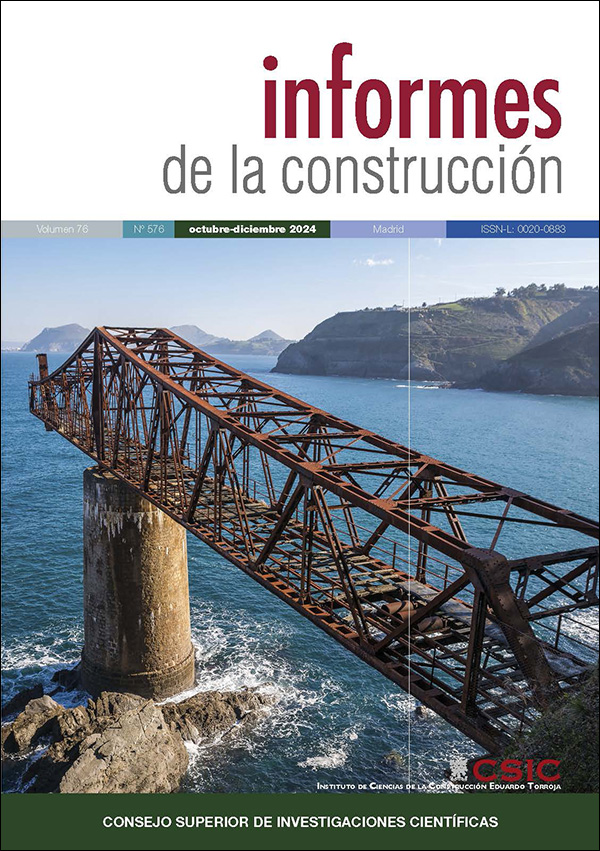The last mineral docks, the rehabilitation of heritage assets in an aggressive environment
DOI:
https://doi.org/10.3989/ic.6563Keywords:
Industrial heritage, structural analysis, steel structures, rehabilitationAbstract
The recent rehabilitation of three mineral docks paradigmatic of the industrial revolution and of our Heritage, gives rise to establishing an intervention methodology in these structures based on the correct analysis of their strength and durable mechanisms, in addition to the analysis of their heritage values. It is precisely the environment where they are located, their past and future use, which allows establishing the rules of the game for the intervention strategy. The need to preserve the monument in an aggressive natural environment, but at the same time unique from the point of view of the landscape, obliges to deepen into the knowledge of the technological and constructive issues of these constructions.
Downloads
References
Clairac y Saenz, P. (1877-1908). Diccionario de Ingenieria y Arquitectura. Barcelona: Libreria de M. Parera.
Ribera Dutasta, J.E. (1895). Puentes de hierro económicos, muelles y faros sobre palizadas y pilotes metálicos. Madrid: Bailly-Bailliere e hijos.
Aguilar Civera, I. (1998). Aqruitectura industrial. Concepto, método y fuentes. Valencia: Diputació de Valéncia.
Carrión Gutierrez, A. (2015). Planes Nacionales de Patrimonio Cultural. Madrid: Ministerio de Educación, Cultura y Deporte.
Donoso y Sequeiros, I. (2019). Diagnóstico estructural del muelle cargadero de la compañia Tharsis en el Puerto de Huelva. Sevilla: Universidad de Sevilla.
Bailey Davier, J., Vizcarrondo, J.R. (1896). Embarcadero de Dícido. Memoria y planos. Archivo General de la Administración. Caja/legajo24/01225.
(1883). Proyecto de un cargadero para minerales en la ensenada de Dícido, inmediata a Castro Urdiales. Madrid: Archivo General de la Administración Caja/legajo24/01220.
Barbadillo, F., Bustillo, E. (1938). El nuevo cargadero de mineral de Dícido.
Gris Martínez, J. (2003). El embarcadero del Hornillo, 1903-2003.
Sánchez Picón, A., Torres López, R. (2007). El cable ingles de Almería. Centenario del cargadero de mineral el alquife. Almería: Junta de Andalucía. Consejería de Cultura.
Dory, A. (s.d.). Los embarcaderos cantilever de la costa cantábrica. 1300.
Navarro Vera, J.R. (2001). El puente moderno en España 1850-1950. Madrid: Fundación Juanelo Turriano.
Mendizabal, D. (1925). Estudio de una nueva instrucción para el cálculo de tramos metálicos. Madrid.
Eiffel, G. (1900). La Tour de trois cents métres. París: Societé des imprimeries lemercier.
Westhofen, W. (1890). The Forth Bridge. Reprinted from Engineering. Londres: Offices of Engineering.
Rabun, J.S. (2000). Structural analysis of historic buildings. New York: John Wiley & Sons, Inc.
Helmerich, R., Brandes, K., Herter, J. (s.d.). Full scale laboratory fatigue test on riveted steel bridges. Vol 76 “Evaluating of existing steel and composite bridges”.
ICOMOS. (2003). Principios para el análisis, conservación y restauraión de las estructuras del patrimonio arquitectónico. Victoria Falls.
ICOMOS. (2000). Carta de Cracovia 2000. Principios para la conservación y restauración del patrimonio construido. Cracovia.
Published
How to Cite
Issue
Section
License
Copyright (c) 2025 Consejo Superior de Investigaciones Científicas (CSIC)

This work is licensed under a Creative Commons Attribution 4.0 International License.
© CSIC. Manuscripts published in both the print and online versions of this journal are the property of the Consejo Superior de Investigaciones Científicas, and quoting this source is a requirement for any partial or full reproduction.
All contents of this electronic edition, except where otherwise noted, are distributed under a Creative Commons Attribution 4.0 International (CC BY 4.0) licence. You may read the basic information and the legal text of the licence. The indication of the CC BY 4.0 licence must be expressly stated in this way when necessary.
Self-archiving in repositories, personal webpages or similar, of any version other than the final version of the work produced by the publisher, is not allowed.















